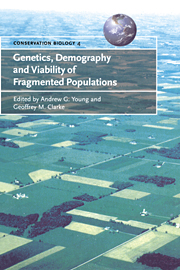Part II - Animal case studies
Published online by Cambridge University Press: 29 January 2010
Summary
The conceptual framework underlying the predicted genetic and demographic consequences of habitat fragmentation has been founded broadly on the theory of island biogeography (MacArthur & Wilson, 1967; Soulé & Wilcox, 1980b). As a consequence, much of the early fragmentation literature revolved around the insular concepts of size and isolation and the balance between extinction and colonisation (e.g. Lovejoy et al., 1986; Wilcove et al., 1986). The majority of studies at this time focussed on patterns of species diversity (with an emphasis on birds) rather than the impacts on community structure, individual species or populations. As empirical data on species diversity accumulated and were found to generally support the island-biogeographic models of fragmentation, the principles began to be applied to individual species within fragmented landscapes. In addition, island-biogeography concepts formed an integral component of metapopulation theory (Hanski & Gilpin, 1991a), reserve design (e.g. Diamond & May, 1976; Soulé & Simberloff, 1986) and wildlife corridors (Soulé & Gilpin, 1991; Hobbs, 1992).
Over the last decade the number of studies examining the effects of fragmentation on individual species has risen almost exponentially, again with an emphasis on the impacts of reduction in size and increased isolation of individual patches within a fragmented landscape. To date, most of these studies have dealt with animals rather than plants (see introduction to Part III, p. 237). Among the animals the primary focus has been on birds and mammals, with considerably less attention paid to fish, reptiles and amphibians and only a handful of studies on invertebrates (a symptom of most modern conservation).
- Type
- Chapter
- Information
- Genetics, Demography and Viability of Fragmented Populations , pp. 127 - 128Publisher: Cambridge University PressPrint publication year: 2000

